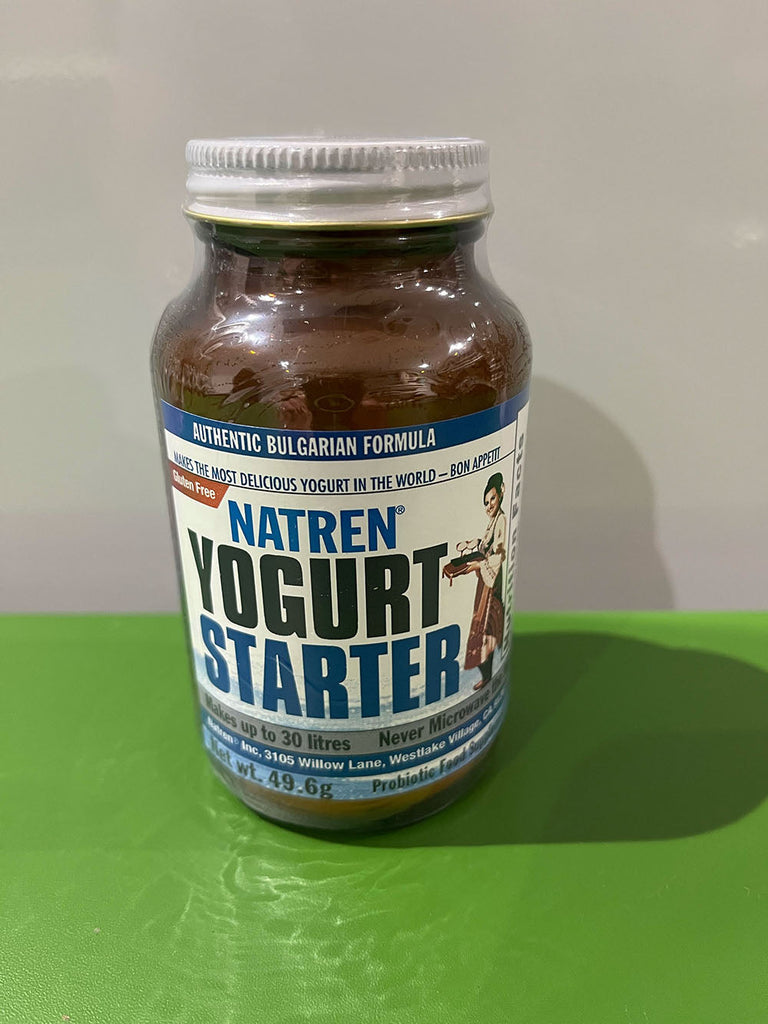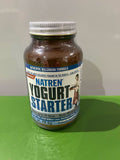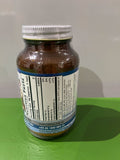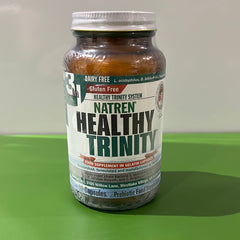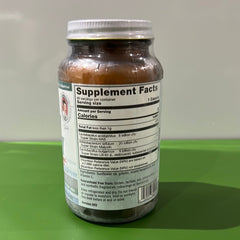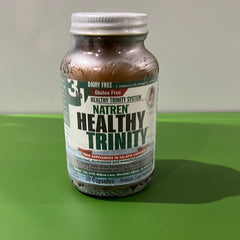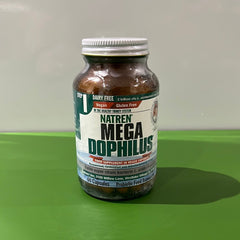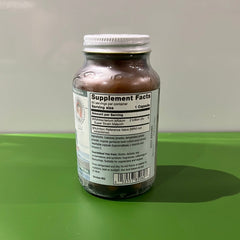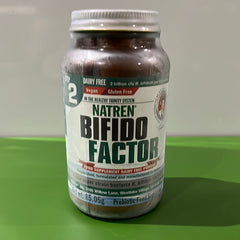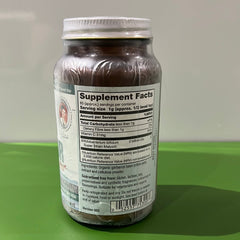Natren Probiotics Yogurt Starter
- Categories: Natren
- Availability:
We highly recommend choosing an Express delivery service at checkout.
Natren Yogurt Starter makes it possible for you to make your own Bulgarian style yogurt. Bulgarian yogurt is light, tangy, smooth and creamy. This distinctly tangy, some save sour, yogurt made Genghis Khan and his troops infamous. Called kiselo mliako (sour milk), in Bulgaria, Bulgarian yogurt contains lactobacterium bulgaricum, which is exclusive to the country. Much research has been done on the longevity of Bulgarian people. In 1908 , Iliya Mlechnikov was awarded the Nobel Prize for his research on Bulgarian villagers; many of whom lived to 100 years.
Natren Yogurt Starter Makes up to 34 Litres Natren Yogurt Starter is an easy and delicious way to add probiotics to your diet. This yogurt is a tasty, Bulgarian recipe full of protein, calcium, and super strain probiotics. The creamy thick deliciousness is a nutritional treat your whole family can enjoy! Yogurt Starter :
-
Uses a traditional recipe for smooth, yummy yogurt
-
Is naturally sweet with no preservatives, artificial colors or flavors.
-
Provides the beneficial bacteria that makes it a healthy treat
-
A delicious source of protein and bioavailable calcium
Natren Yogurt Starter dairy powder is a recipe passed down over generations. It has graced the table of royalty the world-over. The Bulgarian recipe is filled with creamy healthy goodness. Eat it plain, straight from the fridge, use it as a sour cream substitute on your tacos and potatoes, or dress it up with your favorite fruit and honey to satisfy that sweet tooth! Natren is a California company started by husband and wife, Yordan and Natasha Trenev. Natasha’s family supplied yogurt to King Peter II. Get the royal treatment with Natren's Yogurt Starter 100% potency guaranteed through the printed expiration date.
DAIRY – Loose Powder
PROBIOTIC STRAINS USED: 1 tsp (2 grams) contains: Lactobacillus bulgaricus , LB-51 1 billion cfu Streptococcus thermophilus , BC 122 1 billion cfu SIZE: 50g bottle

DIRECTIONS FOR MAKING YOGURT FROM NATREN'S YOGURT STARTER
Making homemade yogurt with Natren Yogurt Starter will easily fit into your busy lifestyle! Once you have mastered the method, it usually takes less than 30 minutes to prepare the milk for incubation.
Equipment
Natren Yogurt Starter
2 litres of milk (do not use powdered milk)
Thermometer (temperature range 110° - 200° / 40° - 95°)
2 - 3 litre double boiler with lid* or yogurt maker
If your double boiler or pan is oven proof and has a tight fitting lid, you do not need a separate utensil. While the casserole technically does not have to be "oven proof" these types of casseroles are preferred because they are better insulated and retain heat longer.
If you do not own a yogurt maker there are many methods that can be used for incubation. The oven method is the easiest and most convenient. Oven incubation can be done at night while you are sleeping. The oven is off and simply provides an insulated place for the yogurt bacteria to ferment. If you have an electric oven, wrap the pan in a towel. If you have a gas oven with a pilot light, place the pan on the top shelf at the back. Centuries before gas and electric heat sources, people were very innovative finding ways to incubate yogurt. Be creative! If your oven is in use, try wrapping the pan in a towel and placing it in a small insulated chest or wrap the container with a heating pad.
Let's Get Started
Read through the instructions before you begin. Gather your equipment and see how easy it is to make great tasting, healthy yogurt.
1. HEATING THE MILK
To prevent scorching, heat the milk in a double boiler or water bath. Use a stainless steel, glass or enamel container. Heat the milk to 180° - 190°F (82° - 88°C) for 20 to 40 minutes to achieve gourmet results. Low fat and non-fat milk must be heated the full 40 minutes. Do NOT heat the milk in a microwave oven.
For faster yogurt
Heat the milk to 190° - 200°F (88° - 93°C) for 5 to 10 minutes, watch carefully to avoid boiling the milk. This first step breaks down the protein molecules in the milk, while evaporating a great deal of water. It also kills any existing bacteria. The longer the milk cools, the thicker and tastier the finished product.
2. COOLING THE MILK
The milk must be cooled to 110° - 115°F (43° - 46°C) before adding the yogurt starter. This is important so the bacteria will thrive and the yogurt will set properly. The milk cooling process may be accelerated by placing the pan in cool water (be careful not to splash any water in the milk). You may also stir the milk to hasten the cooling. This takes about 10 minutes.
3. ADDING THE STARTER
Use 1 to 2 level teaspoons of Natren's Yogurt Starter. Place the starter in an empty cup and pour about 2 tablespoons of the cooled 110° - 115°F (43° - 46°C) milk into the starter and stir to form a smooth paste. Continue adding milk to the paste, thoroughly blending after each addition until the cup is nearly full. Stir this mixture gently back into the pan of cooled milk and mix thoroughly.
4. INCUBATION
Yogurt makers: Follow the manufacturer's instructions for incubation.
Oven method: Gas oven - place on the top shelf, in the back.
Electric oven: Wrap the container with a towel before placing in the oven.
It is best to remove the yogurt as soon as it is set to preserve sweetness, check after 6 hours. If you are incubating overnight, take the yogurt out of the oven when you arise in the morning.
HOW DO YOU KNOW WHEN IT'S YOGURT?
Yogurt is ready when it has thickened and has a custard-like appearance - or separates from the edge of the container. If longer incubation time is needed, check every 15 to 20 minutes. The yogurt will continue to thicken slightly while cooling.
TYPES OF MILK
Whole milk provides a sweeter, thicker, creamier yogurt. Low and non-fat milk can be used but the fat soluble vitamins A, D, E and K are depleted and the yogurt will be slightly more tart and tangy. With goat's milk, you may have a more liquid yogurt because the protein to fat ratio is different than cow's milk. Goat's milk also has more natural inhibitors to coagulation. You may add a six ounce can of condensed milk or one heaping tablespoon of non-fat powdered goat's milk (mix in blender to remove lumps). Soy milk is another delicious alternative.
REFRIGERATION AND STORAGE
When set, refrigerate the yogurt and leave it undisturbed for several hours until thoroughly chilled. There will be a watery separation on the top - this is whey - do not stir it in - pour or spoon it off. If you desire, you can save it and use it in place of other liquids in cooking.
Finished yogurt will be good for at least 10 days. It is not a good idea to add anything to the yogurt while it is being stored, as this may reduce the beneficial bacteria and cause fermentation. As the yogurt ages, it will become more tart and tangy. It is 100% natural, has no stabilizers or preservatives and it has not been pasteurized after culturing (all of which keep commercial yogurt artificially sweeter longer). If you plan to make yogurt cheese from the yogurt, this should be done within 10 days - before the yogurt becomes too tart.
USING YOGURT IN COOKING
Yogurt is a wonderful, low-calorie, low-fat substitute for sour cream, cream cheese and other dairy products. More and more recipes are replacing high-fat cheeses with yogurt. Try substituting yogurt cheese for cream cheese in your favorite cheesecake. Use yogurt in place of sour cream on potatoes, in dressings, sauces and marinades. Yogurt cheese is very easy to make. Simply suspend plain yogurt in cheesecloth over a bowl, let the whey drip out for 12 - 36 hours, refrigerate. Yogurt cheese will keep for several weeks. In our test kitchen, if we have not used all our yogurt after a week and it is beginning to get tart, we extend its useful life by making yogurt cheese.
TROUBLESHOOTING
There are many variables that can affect the outcome of your yogurt: timing, humidity, drafts, the age of quality of your milk, etc. Don't be discouraged if you do not get a firm set the first time. Try again, it's worth the effort. You can always use the un-set yogurt in baking, soups or sauces.
Too runny?
Sufficiently heat the milk to denature the protein and natural inhibitory substances (and any antibiotic residues)
Milk temperature should be between 110° - 115°F (43° - 46°C) when the starter is added.
If the outside temperature is cold, pre-warm your utensils with warm water.
Aluminum utensils may adversely affect your finished yogurt.
Your heat source temperature should be constant.
Test your oven temperature. If your oven is too cool, use a heavier pot or carefully pre-heat and then turn off your oven. Do not put yogurt in an oven over 120°F / 49°C.
Do not heat in a microwave oven.
Do not start with reconstituted powdered milk.
Too lumpy?
The starter must be mixed thoroughly into the cooled, pre-treated milk.
Use only the recommended amount of yogurt starter. If you use too much starter, the bacteria will be crowded into making lumpy yogurt - too little yogurt starter and it won't thicken.


